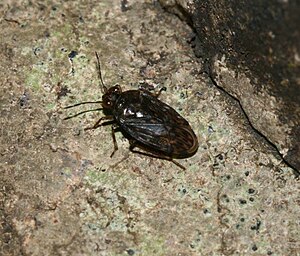Saldula saltatoria
| Saldula saltatoria | ||||||||||||
|---|---|---|---|---|---|---|---|---|---|---|---|---|

Saldula saltatoria |
||||||||||||
| Systematics | ||||||||||||
|
||||||||||||
| Scientific name | ||||||||||||
| Saldula saltatoria | ||||||||||||
| ( Linnaeus , 1758) |
Saldula saltatoria , also known as the common hippopotamus, is a type of bug from the family of the bank bug (Saldidae).
features
The bugs are 3.4 to 4.5 millimeters long. It is difficult to distinguish from other, closely related species of the genus Saldula . Saldula saltatoria has at least two pale spots on the costal margin of the hemielytres , but overall the coloration of the hemielytres is very variable. On the rails ( tibia ) of the forelegs there is a dark line in the middle, but this is not fused with the dark base and apex of the rails, as is the case with Saldula palustris . The sides of the pronotum are clearly curved outwards. Most are Imagines submakropter, they have so easily shortened wings. Macroptere individuals with fully developed wings occur only rarely. Animals from higher altitudes usually have a darker color than those from lower altitudes.
Occurrence and habitat
The species is distributed holarctic . It is the most common type of bank bug in Central Europe, widespread and usually occurs in large numbers. The banks are populated by fresh water, from small bodies of water to large lakes and rivers. The species can also be found on the edge of salt water and in raised bogs , and also in less humid habitats such as loosely overgrown ruderal meadows , on fallow land and fields. In the Alps, it rises to around 2000 meters above sea level.
Way of life
Like all bank bugs, Saldula saltatoria feeds predatory. One to two generations occur per year, depending on the habitat and weather conditions. The females lay their eggs from April in damp mud or between dead plant parts. Winter hibernation occurs as an adult animal near the inhabited waters in grass groves and moss, and more rarely in loose, dry soil litter at forest edges, in heaths or on ruderal areas. The bugs sometimes fly very far to find the latter hibernation places.
supporting documents
Individual evidence
- ↑ a b c d Ekkehard Wachmann , Albert Melber, Jürgen Deckert: Bugs. Volume 3: Pentatomomorpha I: Aradoidea (bark bugs), Lygaeoidea (ground bugs, etc.), Pyrrhocoroidea (fire bugs) and Coreoidea (edge bugs, etc.). (= The animal world of Germany and the adjacent parts of the sea according to their characteristics and their way of life . 78th part). Goecke & Evers, Keltern 2007, ISBN 978-3-937783-29-1 , p. 95 f .
- ↑ a b Saldula saltatoria. British Bugs, accessed March 7, 2014 .
literature
- Ekkehard Wachmann , Albert Melber, Jürgen Deckert: Bugs. Volume 3: Pentatomomorpha I: Aradoidea (bark bugs), Lygaeoidea (ground bugs, etc.), Pyrrhocoroidea (fire bugs) and Coreoidea (edge bugs, etc.). (= The animal world of Germany and the adjacent parts of the sea according to their characteristics and their way of life . 78th part). Goecke & Evers, Keltern 2007, ISBN 978-3-937783-29-1 .
Web links
- Saldula saltatoria at Fauna Europaea. Retrieved March 7, 2014